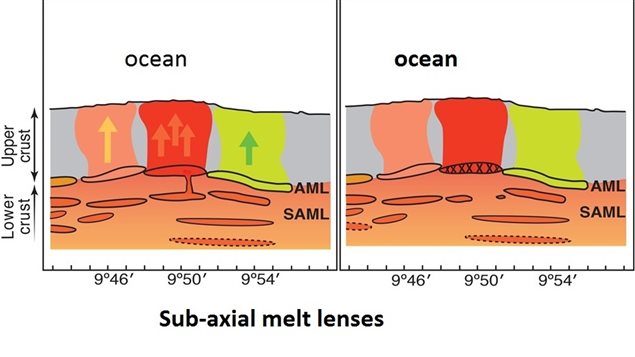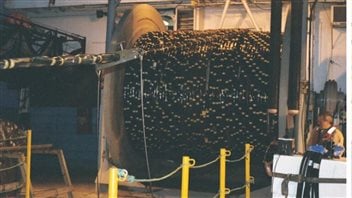One theory held that the earth’s crust under the sea was and is formed at mid-ocean ridges from a single magma layer spread around the middle of the earth’s crust
Mladen Nedimović is an associate professor in Earth Sciences at Dalhousie University in Halifax, Nova Scotia, as well as Canada Research Chair in geophysics and author and co-author of several research papers on the subject.
Listen
The original theory is that as tectonic plates move apart in mid-ocean, it allows magma to pool under the ridge.
The new surface crust is formed as upward pressure builds within the large magma pool (axial magma lens -AML) beneath the surface crust.
As the plates continue to move apart, it results in less downward pressure on the magma. The result is magma/lava release to the “surface” which then cools forming new upper crust.
Professor Nedimović is co-author of a new paper in the online journal Nature Geoscience.
It suggests that an eruption of the main magma pool (AML) can be augmented from smaller magma lenses below, thereby increasing the amount of lava potential.
It also suggest that the lower-level crust is formed, at least in part, from several smaller magma “lenses” which have cooled and hardened.
The research is carried out in the ocean as the earth’s crust is much thinner, and is simpler and more affordable to image there.
He says, “It is much less expensive to study a volcanic system that is below sea level simply because we can run a big ship towing thousands of instruments, whereas on land we would have to plant each instrument separately and that would take forever.”
He adds, “The volcanic systems in the oceanic crust are easier to image because the crust is thin (6 km thick) and simple, opposed to the 40 km thick and geologically complex continental crust.

(ABOVE LEFT) During 2005-2006 eruption : Mid-crustal magma bodies known as axial magma lenses (AMLs) are shown with varying colors to emphasize that this magma reservoir is disconnected. Upper oceanic crust is formed by dyking and eruption (vertical magma movement, see arrows) from these lenses that were first imaged in 1978. First images of the sub-axial magma lenses (SAMLs) were published only this Fall. SAMLs can feed magma to AMLs during an eruption, as shown
(ABOVE RIGHT) In 2008, after eruption: The AML and SAML beneath the central eruption cite are partially (AML cross-hatched pattern) to fully (SAML gap) crystallized owing to draining of melt during the eruption. Presence of a possible deeper SAML is marked by a dashed outline

The research indicates that the earth’s crust formation is much more dynamic and complicated than previously thought
Professor Nedimović says, “It also favours the emerging view that volcanoes have a complicated plumbing system consisting of many interconnected sills and magma conduits. We still have a lot to learn about what goes on beneath the surface of the Earth.”
He points out that it is only with the arrival of new technology that the complexity of the deep earth magma formations are able to be detected.
Related research papers, : Nature Jan 2012







For reasons beyond our control, and for an undetermined period of time, our comment section is now closed. However, our social networks remain open to your contributions.